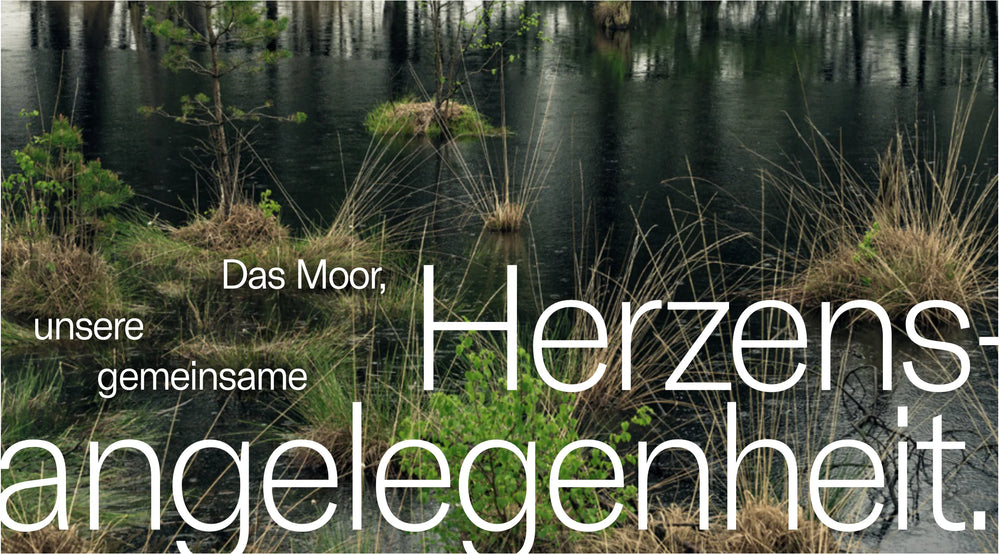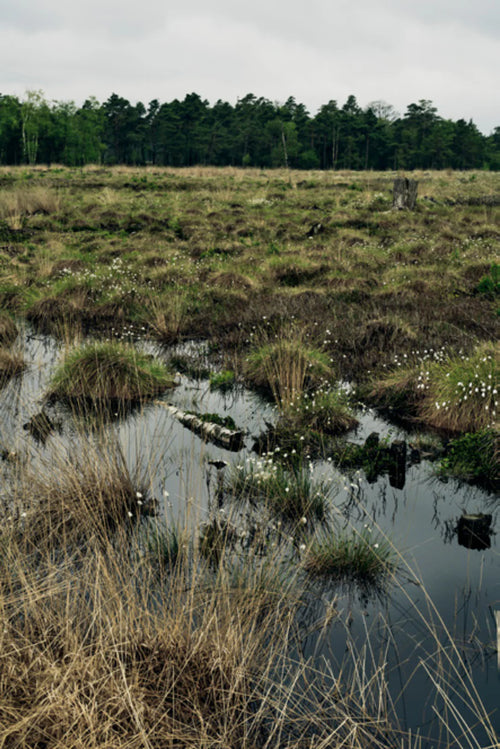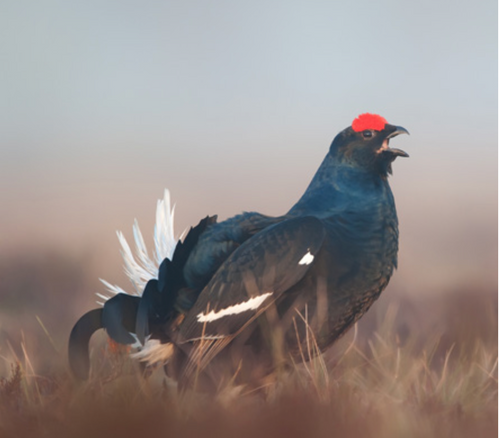
A matter close to our hearts: Moor
Bogs have fascinated people since time immemorial. Historians, biologists, filmmakers, myth collectors, storytellers, and many others have found a treasure trove of diverse inspiration here.
Admittedly, the word "moor" and its sound certainly sends shivers down some people's spines. Thoughts of horror and fog, of sinking into the ground, perhaps even bog bodies come to mind. In purely objective terms, the word originates from Germanic and was used thousands of years ago to describe particularly wet, even muddy landscapes.
A heritage of nature, unique and many thousands of years old.
Such legendary, enchanted landscapes can still be found all over the world today – including on the western edge of the Lüneburg Heath nature reserve, near the small town of Schneverdingen. The area of interest is called the Pietzmoor Complex. It consists of the Bockheberer Moor, the Möhrer Moor, the Pietzmoor, and the Freyersener Moor. Moor growth began here after the end of the last Ice Age and was favored by hollows above impermeable clay layers in the subsoil. Sufficient precipitation led to a water surplus, which favored the growth of peat mosses, the building blocks of moors. And in the case of the Pietzmoor, this is not a given: this approximately 450-hectare raised bog landscape developed on the border between the Atlantic and continental climate zones. Here, the amount of precipitation is just sufficient to allow the development of a raised bog. Over the course of approximately 8,000 years, the peat mosses, known as sphagnum, grew very slowly but steadily out of the influence of the groundwater. A bog up to 7 meters high formed, which, arching like a primordial glass, overgrown the hollow over the course of several thousand years. It's hard to imagine the history and stories this bog has "experienced."
The moor from a scientific perspective.
The term "moor" is now only used to describe a very specific type of wetland. The key factor is the formation of peat, a natural product. A raised bog, as a very wet ecosystem, represents a very special habitat. As mentioned at the beginning, it exists without the influence of groundwater and is fed by precipitation. In this case, we speak of ombrogenic bogs, also known as "rain bogs."
Raised bogs are also very nutrient-poor. They therefore offer challenging conditions for flora and fauna: a unique habitat for highly specialized species. Characteristic plants are peat mosses (sphagnes), the essential building blocks of bogs. Their tactic: Over the course of decades, they lose their connection to the subsoil and the water, and grow only on their own old, dead plant remains. The peat moss grows towards the light, and very slowly, at only about 1 mm per year. In this process, the lower part of the plant dies – and from these dead plant remains, peat is formed. This peat consists almost exclusively of carbon compounds.

Important for the climate.
Now a reaction occurs that is relevant for the climate: If there is enough water in the bog body (i.e. the peat body plus the thin top layer of the regrowing peat mosses), the peat does not come into contact with oxygen - and the carbon remains stored.
Peatlands represent a very significant carbon store. This is proven by impressive statistics: Peatlands store around 30 percent of the earth's carbon. According to the German Federal Association of the Environment, Nature Conservation, Building and Nuclear Safety (BUND), peatlands worldwide bind twice as much CO₂ as all forests combined. And this despite the fact that the area of peatlands is significantly smaller than that of forests. Peatlands therefore represent a very significant carbon store.
However, many peatlands around the world are not doing very well today. Peatlands are being drained for agricultural and forestry use, as well as for peat extraction. In some areas, peat extraction is even still permitted in Germany, even though the peatlands there took 1,000 years to grow just one meter.
The extracted peat is usually used as soil substrate for commercial horticulture or as an additive for potting soil from the local garden center. Fortunately, there are now peat-free substitutes available, at least for home potting soil. Manufacturers are conducting intensive research into "peat substitutes." However, replicating the outstanding properties of peat has proven very difficult.
Peat extraction and drainage – catastrophic for the moor ecosystem.
But what happens if the peat isn't decomposed but is also no longer saturated with water? Drainage allows air to enter the bog, mineralizing the peat. This causes large amounts of stored CO2 and nitrous oxide (N2O) to escape. Drainage initiates irreversible processes that lead to rapid deterioration of a bog. Erosion, peat loss, subsidence, and shrinkage occur. Drained bogs cause significant environmental pollution, not only releasing large amounts of greenhouse gases but also carrying nutrients into adjacent waterways.
It is possible to revitalize drained or degraded peatlands.
In addition, dry peat is highly flammable. Thus, if a bog fire spreads underground and burns for a long time, large amounts of stored carbon can be released extremely quickly. Drainage also changes the landscape's water balance. Bogs lose their function as water filters and reservoirs. As intact bogs, they serve as natural buffers. Due to the swelling properties of peat and the ability of vegetation to float, bog bodies can store large amounts of water. Rainwater can be absorbed and released only later. Thus, they make an important contribution to mitigating flood peaks.
Help for the moors – the sooner the better.
Therefore, it is particularly important to preserve as many bogs as possible and to implement restoration measures. After all, it is possible to revive drained or degraded bogs. At least as long as the drying peat mosses are still able to resume their function as water reservoirs once the water returns after restoration.
The opportunity for the Pietzmoor complex.
Despite decades of drainage measures to extract peat using the hand-cutting method, large areas of Pietzmoor represent a "raised bog still capable of renaturalization." In some areas, the "living raised bog" habitat type has even been preserved. Several options exist for revitalizing a raised bog. Rewetting the bog body is the most important measure. If the area can be rewetted by retaining rainwater, other measures are secondary: Retaining water in the area would be achieved by closing existing drainage ditches.
The challenge is clear.
When a moorland degenerates, birch and pine trees increasingly grow. This growth impairs the natural raised moor vegetation in various ways. The emerging woody plants shade the natural vegetation, evaporation draws additional water from the moor, and leaf litter kills the vegetation. One measure to counteract this is the removal of woody growth (de-bushing) by human hand or by grazing with Heidschnuck sheep and goats.
Similar efforts are also being undertaken in Pietzmoor. Until the end of this year, measures are being carried out under the attractive project title "Continuation of the Raised Moor Renaturation Measures in the Pietzmoor Complex" within the framework of the "Special Species and Habitat Protection (SAB)" funding guideline. Funded by the state of Lower Saxony and the European Union, these measures aim to promote valuable species and biota in a raised moor that is as intact and largely open as possible. To achieve this goal, wet sections of Pietzmoor are being cleared of shrubs and regrowth is being pushed back. Heavy machinery has been used on large areas at times to create open moorland by removing trees. Chambers are being built, and the rewetted areas are being grazed by a herd of sheep. It is important to note that it is always a variety of measures that benefits the diversity of moorland species. Only through teamwork can the moor recover.

A home for beautiful specialists.
Animals of various species will benefit: for example, the highly endangered butterflies, the High Moor Blue, and the Greater Celandine – their ranges are expected to expand in Pietzmoor over time. Whether species such as the Marsh Blue and the Cranberry Fritillary, which have not been found in the moor for years, will also be attracted to the renaturalized moorland remains to be seen. There is hope that these species have been able to survive in other moors and will find a home in the Pietzmoor complex. The same applies to the heat-loving grasshopper species, the Variegated Grasshopper. A healthy Pietzmoor also offers shelter to cold-blooded reptiles such as the adder, the common lizard, and the sand lizard.
A beautiful home, the clearing of further areas attracts them. A look into the world of these flying artists reveals that the emerald dragonfly is perfectly adapted to extreme moorland locations and nutrient-poor conditions. Thus, it too will be delighted by the renaturation measures and will hopefully soon be recorded in larger numbers. The blue moor frog and the impressive black grouse are slowly reclaiming Pietzmoor – and demonstrating how grateful nature is for our efforts. Considering all these specialized and beautiful species, the word "moor" no longer gives you goosebumps, but rather makes you beam with joy.
Small stake, big win.
Just 1 euro can restore an area of approximately 1 m². This means that with 500,000 euros, we can significantly improve the conservation status of approximately 50 hectares of moorland. However, sustainable and long-term restoration measures require a great deal of patience. The peat cushions that have since dried out need many years to become saturated with water again. Furthermore, peat extraction has significantly changed the moor's relief. There are now desirable wet areas again – but these are offset by (too) many areas that require further support. And we are working on this, together with you.
Your contribution – our thanks.
We would like to extend our sincere thanks to Prof. Steinkraus Research Laboratories GmbH, who are providing us with significant financial support for the Pietzmoor Complex. By purchasing their products, you're not only doing something good for your skin. You're also making an immensely important contribution to the renaturation of a wonderful and important natural area. Perhaps you'd like to visit Pietzmoor sometime and see the progress for yourself. And remember—if you get your feet wet, that's a good sign!
Stefan Wormanns (Dipl.-Ing. Landscape Architecture and Environmental Planning) has been with the VNP Lüneburg Heath Nature Park Foundation since 2003 and heads the on-site conservation management of the Lüneburg Heath NATURA 2000 site. His primary responsibility is the restoration of the raised bogs in the Pietzmoor complex.
Stella-Marie Weidemann studied wildlife ecology and management in Vienna, specializing in capercaillie and black grouse. With her core expertise in this field, she has been actively involved in on-site conservation management at the Pietzmoor since 2016.